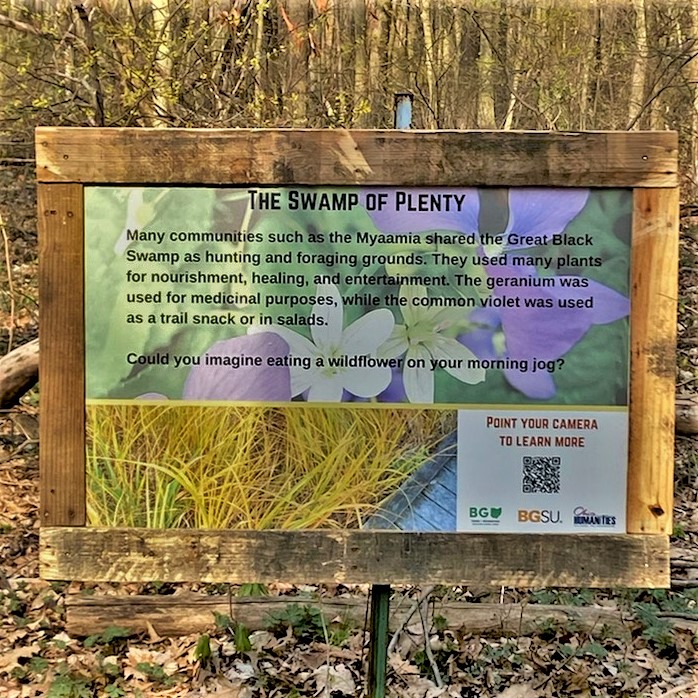
We often associate swamps with mud and obstacles to human life. But they are amazing ecosystems that sustain varied forms of life and help keep the land healthy. We know about this from science, but Native Americans have known this for generations through the ecological knowledge that they passed in oral tradition from generation to generation. In an interview conducted in fall 2019, Dani Tippmann, a member of the Miami or Myaamia tribe and a Plant Tradition Bearer, helped us understand how the Myaamia see the swamp as a sustainer of life. While the tribe is federally recognized as the Miami, we prefer the native spelling, Myaamia.
The Great Black Swamp was once surrounded by Native American villages, which utilized the diversity of landscapes and ecosystems to sustain their daily living. Among them, the Myaamia had a well established presence in the upper Maumee River. The Great Black Swamp was a refuge and a source of multiple resources —plants and animals— that they used for their subsistence and trade. The Myaamia viewed and still view the swamp and other natural resources as a gift that they honor in their daily practices.
The Myaamia cultivate a spirit of thankfulness for the resources that are provided for them and often shared between tribes to make sure that every tribe had enough food and medicine. Thankfulness is also rooted in local knowledge of the land, especially of its plants, wildlife and waterways. The tribe elders are quite important in passing this knowledge down and instill the notion that living beings that can be used but must be respected and listened to. Stories, rituals and the calendar also serve as ways to pass ecological knowledge. In the past, such attitudes were often confused by European settlers as superstition and even lack of ambition to improve the land. It took decades to realize to non-indigenous peoples that the stories and practices encode ecological knowledge that was and still is quite essential to lead a sustainable life.
The Myaamia have used many plants that we see around in the woods and meadows in their daily lives. For example, cattails were used in a number of ways, depending on the time of year. The roots of cattails were edible and could be eaten like a potato. The pollen was used as a flour for cooking, or as a medicine. The fluff of the cattails could even be used as diapers for babies! They ate violets, so abundant in spring time, in salads, or as a snack, picked fresh along the trail. Violets also help treat upper respiratory problems. Geranium is another helpful plant that the Miami used for medicine and it can also still be found in the area. Jack in the Pulpit is another native plant that the Myaamia would slowly cook for a few days. If they tried to eat it before it was done, it would burn their mouths. May apples, also so abundant in St. John’s woods, were also used, but with strong precautions because their roots are poisonous.
From the 1810s to the 1840s the Myaamia were forced to sign treaties and relocate to Kansas and eventually Oklahoma, where the tribe is federally recognized today. Many things have changed, but they keep their beliefs, traditions and social organization alive, much like these old woods have persisted and rebound with the care and love of the community.
Learning More
Watch our webinar, Honoring Our Plants, that featured Dani Tippmann and our park naturalists.
Ethnobotanical databases and dictionaries are an excellent resource. You can search for local plants and trace how different cultures see and use them. Mahkihkiwa, Myaamia Ethnobotanical Database is focused on the Miami. The “Native American Ethnobotanical Database,” although very few were present in this region.
Susan Sleeper-Smith’s Indigenous Prosperity and American Conquest: Indian Women of the Ohio River Valley, 1690-1792 (University of North Carolina Press, 2020) focuses on the vibrant economy and ecological knowledge of the Miami and other Native American groups that were present in the Ohio valley and the southern Great Lakes.
Sources
- Interview with Dani Tippmann, Amilcar Challu, Peter Funk, Jared Miller & Madison Stump, October 22, 2019.
Photo Credits
- All photos were taken/provided by Rob Baither and Cinda Stutzman.
Text, research and content created by Jared Miller, M.A. student in History. Edited by Carolyn Dailey, History senior.

